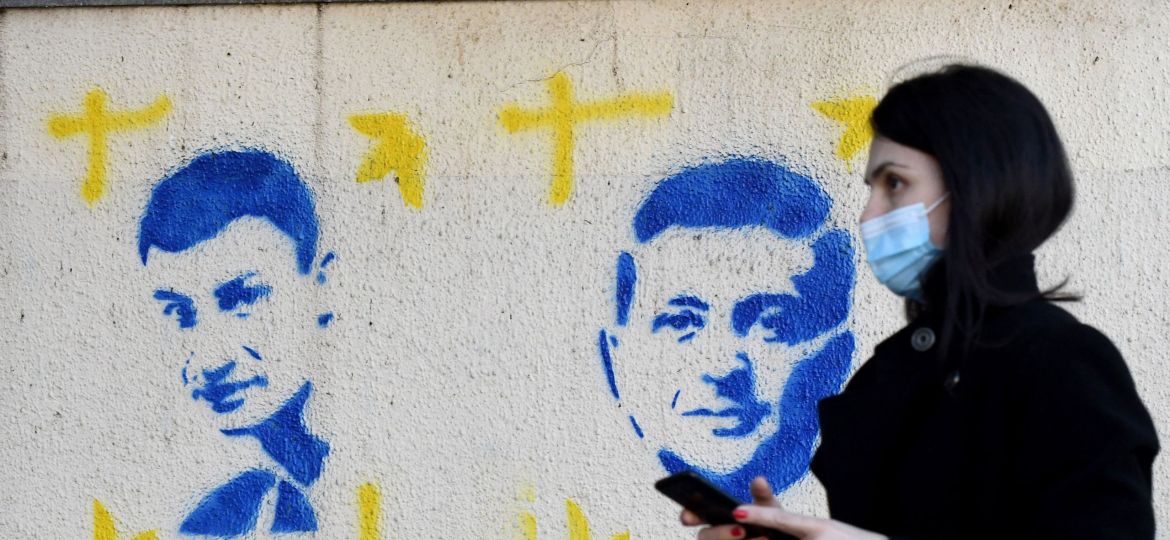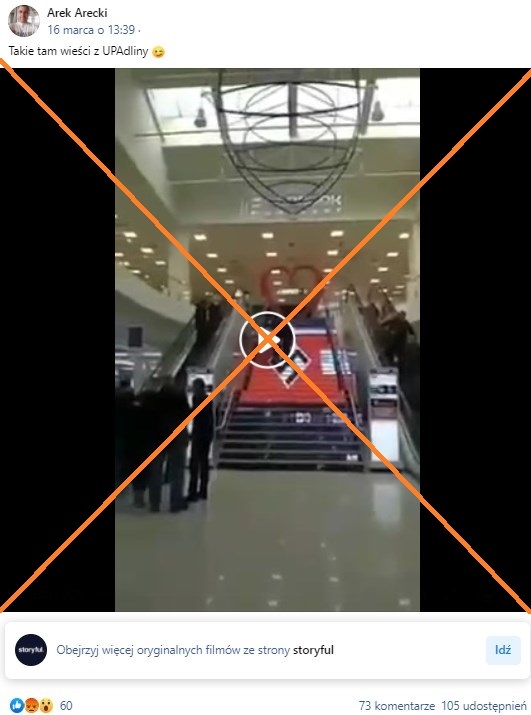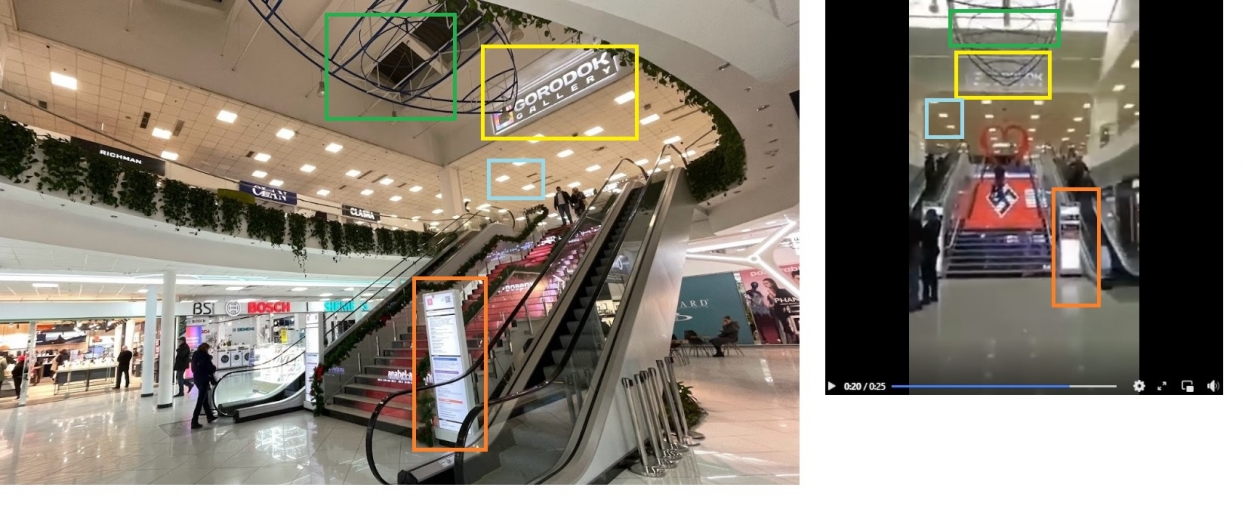
Hundreds of social media users have shared misleading posts of a video showing a large swastika lit up on a staircase in a mall in Ukraine. The image appears to support the Kremlin narrative that its war is needed to “denazify” the country. But the video has been shared out of context: it is actually old footage from 2019 and was the result of a hacking incident, according to the mall where it took place. While a radical far-right does exist in Ukraine, it does not wield power in government and its influence has been greatly exaggerated by Russia, experts told AFP.
More than a hundred users shared a Polish Facebook post with the video that was published on March 16 and read: “Just the news from the UPAine”. The video was also posted by some English Facebook and Twitter accounts.
“Fascism is blooming and Poles are donating and arming them,” wrote one commentator beneath the Polish post.

The term “UPAine” [“UPAdliny” in Polish] is a form of wordplay combining the words Ukraine and UPA, which are the initials of the Ukraine Insurgent Army. The UPA was a World War II-era Ukrainian nationalist paramilitary that fought alongside Nazi Germany before later opposing it.
Their legacy remains controversial in Ukraine, with some seeing the group as national heroes and others considering them Nazi collaborators. The history is also a source of tension with Poland, who accuses the group of committing a genocide against Poles in the 1940s. The Ukraine parliament drew criticism in 2015 when it voted to recognise the UPA as “independence fighters” and introduced penalties for criticising the group.
The video from the mall fits the Kremlin’s rhetoric that Ukraine is led by neo-Nazis — a claim that Vladimir Putin has been using to justify his war.
The country’s leader Volodymyr Zelensky, however, is Jewish, and experts say that while there is a nationalist far-right in Ukraine, this fringe group is not in power and their influence has waned significantly in recent years. Let us explain.
Mall said it was ‘hacked’
To find the origins of the video with the swastika, we did a reverse image search in Google of key frames and found that a similar image appeared in a Greek article from February 2019 with the headline: “A Nazi flag in a shopping mall”. We also found some articles that said the image came from a shopping centre named Gorodok in Kyiv.
By looking at photos of the shopping centre on Google Maps, we were able to confirm it is the same mall and staircase seen in the video, with the matching elements circled below.

On February 18, 2019, the video was tweeted by Eduard Dolinsky, the director of the Ukrainian Jewish Committee . The Times of Israel also reported on the incident, saying that according to Dolinsky, the footage was captured by a shopper on February 16, 2019 “hours before several hundred nationalists marched through Kyiv carrying torches”.
The Euromaidan Press, an online English-language site launched by activists in 2014, found that the original video was published on YouTube by Kristina Samharadze, a Kyiv resident with eleven followers. “There is no fascism in Ukraine,” the description says sarcastically, adding that this took place on February 16, 2019 in the Gorodok shopping mall.
Polish articles from 2019 (1, 2) about the incident mentioned that the mall posted an apology and explained what happened on their Facebook account:
“Dear visitors of the Gorodok Gallery Shopping Center!
We apologise for the situation that happened this weekend with the LED staircase in our shopping centre. Our computer system has been hacked. Unfortunately, we are not the first to suffer from the actions of the attackers. Management and staff have nothing to do with the information posted on the LED stairs and do not in any way support such actions. We are now actively looking for individuals involved in this attack. We hope for understanding and we are grateful to everyone who did not remain indifferent! We apologise once again and warn other public institutions of the possibility of a similar situation”.
In another Facebook post the mall said a criminal investigation had been launched.
Ukraine’s ambassador to Israel Hennadii Nadolenko told The Jerusalem Post at the time that the government in Kyiv regarded “this outrageous incident with the hacker attack in the Gorodok Gallery shopping mall as part of a Russian hybrid information warfare”. AFP was not able to verify this claim.
Origins of Kremlin’s ‘neo-Nazi’ narrative
Maria Domanska, an expert in Russian politics at the Centre for Eastern Studies, told AFP Putin has accused Ukraine of Nazism in hopes it will rally domestic support around his invasion of Ukraine.
“The (second world) war and the victory over Nazism is practically the only historical event that unites Russians in general. The Kremlin hopes that such an anti-Ukrainian narrative will be supported by the public opinion for its aggressive foreign policy,” she told AFP.
The Kremlin claim that Ukraine is run by fascists started gaining traction during the 2014 Maidan protests that ousted pro-Russian President Viktor Yanukovych, said Adrien Nonjon, a researcher at the French institute Inalco and a specialist in Ukraine and the post-Soviet far-right. He noted how certain moves by Ukraine’s next pro-West president Viktor Yushchenko — such as the decision to brand the UPA as independence fighters — did also alarm Russians and Russian speakers.
While far-right nationalists took part in Ukraine’s 2014 protests, which drew from a broad swathe of society, they gained outsized publicity for defending the protesters from state security forces, explained Krzysztof Nieczypor from the Centre for Eastern Studies.
“Although members of these organisations were marginal among the demonstrators, due to their organisation and readiness to actively resist the regime of Viktor Yanukovych, they were the most visible and recognisable group on the Maidan,” Nieczypor said.
Later that year many nationalists “joined the ranks of volunteer battalions fighting against pro-Russian separatists supported by the armed forces of the Russian Federation” in Donbas, Nieczypor said. “The courage and combativeness of these units, especially the Azov battalion, made these organisations quite popular among young people fighting in the east of the Ukrainian state,” he added.
The Azov battalion was created in 2014 by far-right activists and notoriously used symbols echoing Nazi emblems. It was later integrated into Ukraine’s National Guard.
But Nieczypor said the influence of such groups has been vastly overstated by Moscow. “In the Ukrainian army, which counts almost 250,000, the influence of nationalist groups is minimal – the Azov regiment has about 2,500 soldiers, which makes them no more than 1 percent of the total Ukrainian armed forces. Moreover, during the eight years of the formation’s existence, there has been a significant change in its image (the regiment became part of the National Guard subordinated to the Ministry of Internal Affairs), which was the result of the process of purging the organisation of individuals with radically right-wing views.”
Andreas Umland, an analyst at the Stockholm Centre for Eastern European Studies, also noted that the battalion, which initially included “far-right racists”, has since become “de-ideologised” and a regular fighting unit.
Its recruits now join not because of ideology but because “it has the reputation of being a particularly tough fighting unit,” Umland said.
Far-right fails at the polls
Acts of violence and intimidation by Ukraine’s radical far-right have certainly been a cause of concern in recent years, as noted in this 2020 report by Freedom House, a US human rights group.
But experts say that contrary to Putin’s allegations, such groups are not in government in Ukraine and have found increasingly minimal electoral support over the past decade.
For instance, since their greatest victory in 2010 with 10 percent of the vote, the ultra-right Svoboda party’s success at the ballot box has continued to diminish in the two elections since, with currently only one MP in parliament.
“Nationalist organisations in Ukraine do not have much support. In the Verkhovna Rada (Ukraine’s parliament) out of 432 deputies there is only one female parliamentarian from the Svoboda party,” Maria Piechowska, an analyst from the Polish Institute of International Affairs, told AFP.
“The popularity of nationalist parties is actually limited only to their leaders, and even their recognizability does not provide opportunities to gain political influence, ” Nieczypor added.
After Russia’s invasion on February 24, a letter signed by hundreds of scholars around the world condemned the Russian government’s equation of the Ukrainian state with the Nazi regime to justify its invasion. Such rhetoric is “factually wrong, morally repugnant and deeply offensive to the memory of millions of victims of Nazism and those who courageously fought against it,” they wrote.
